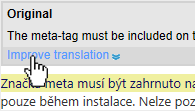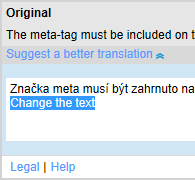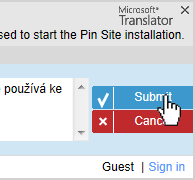Machine translated articles, for obvious reasons, are usually of a lower quality than professionally translated ones. However, translation machine learns from corrections and constantly improves its output. Microsoft now provides a tool that allows anyone to improve the quality of machine-translated articles by proposing better translations.
Improving the translation
Whenever you see a bad translation, give the translation machine a quick language lesson. Use simple corrections to make support articles better for others.
-
Point to the text you want to improve, and then select "Improve translation".

-
Change the text.

-
Select Submit.

Note: Corrections will be evaluated by a Microsoft expert before they get published.
Information about the Machine Translation Service
The Machine Translation Service is designed for users who do not understand English well. Machine translated articles are often of a lower quality than articles professionally translated by humans.
Machine translation technology has improved greatly in recent years—thanks to continuing studies of how machines translate. Still, it does produces linguistic and technical errors. You can now participate in the efforts to improve translations by providing corrected data in local languages.
You can change the language by selecting on the language name next to the world icon at the bottom of the article and selecting the locale.
Anytime you move the mouse over the text, the original English version will appear.
Improved translations with Collaborative Translation Framework
The Collaborative Translation Framework (CTF) provides users with the ability to correct machine translated articles. Now you can contribute to and improve the translation in any Knowledge Base article that you're reading by selecting Improve translation.
The machine-translated article includes the Improve translation functionality by default:
-
Just point to the text you want to improve in an article and the options for improving the translation will appear. Select Improve translation.

-
Make the correction.

-
Select Submit.

You can also see the original English text to get a better understanding of how to translate.
Note: If a user proposes a translation and selects Submit, that translation is saved in the database. If that translation is then accepted by a moderator, it will be used when the article is retranslated.
The purpose of this tool is not to make machine-translated articles perfect nor to bring these articles to the level of professional translations. The purpose of this tool is to enable users to correct sentences that make the article difficult to understand, or plainly wrong.
Errors that do not prevent the meaning of the article to be conveyed should be ignored. Only mistakes that make the article wrong or difficult to understand should be corrected.
Here are some guidelines to follow:
-
Do not add new information to the translation, and do not remove information that is in the original English article. Source text and translated text must correspond, sentence by sentence. The corrections provided are stored in a dictionary and will be re-used each time the same sentence is used.
-
If the original English content is not correct and needs to be updated, then please send feedback to the English authoring team rather than just correcting the translated versions.
-
Do not abbreviate Microsoft product names.
-
If Microsoft product names or user interface (UI) terms are translated incorrectly, please send feedback to PQO MT KB Feedback (pqomtfbk@microsoft.com), with a list of incorrectly translated terms or names (English and translation). This way we can update the dictionaries and apply systematic corrections across articles.
-
For Spanish, please do not use regionalisms when updating corrections. Use “global” Spanish instead.
Examples of errors to correct:
-
Words are dropped: Sometimes, negation is dropped in the machine-translated version-this is a priority 1 issue that needs to be corrected if discovered. Similarly, for some languages, verbs can be dropped and it is important to correct such cases.
-
Command lines are corrupted by machine-translation. This is important to correct, otherwise the article will create problems for users.
-
Terminology errors: For example, “driver” translated to mean the driver of a vehicle rather than a software or hardware driver.
-
Phrases left in English when they should be translated.
-
Phrases translated when they should be left in English.
-
Error messages translated incorrectly.
-
Confusing sentences: The translation is so bad that the sentence is difficult to understand.
-
Sentences that require effort to be understood, because of the low translation quality.
-
Incorrect links.
All these are examples of errors that prevent users from understanding the article and putting the information to good use. Grammatical errors or word order errors do not need to be corrected, unless they make the meaning difficult to understand. In fact, it's not possible to correct everything, because there are too many possible issues and too many articles. When they are corrected and republished, these articles will still be machine-translated articles and will be published with the disclaimer, so general users will not expect perfect translations. What is important is to correct machine-translated articles so that they become helpful for general users.
In some cases, corrections have already been proposed by other users.This is indicated in the editing window, and users can then propose another correction or vote for an existing one.
In the following image, you can see the original machine-translated version followed by the Machine Translated icon (

Corrections proposed by other users can be:
-
Edited
-
Selected (vote for the translation)
-
Reported as offensive

Note: Users can also edit the machine-translated version if they prefer, and propose a completely different translation. The same options are available for the machine-translated version as for the proposed corrections (Edit, Select or Report). Any suggested translation has to be accepted by a moderator before it is displayed in the article when the article is retranslated.










